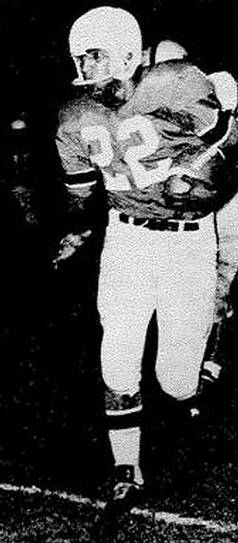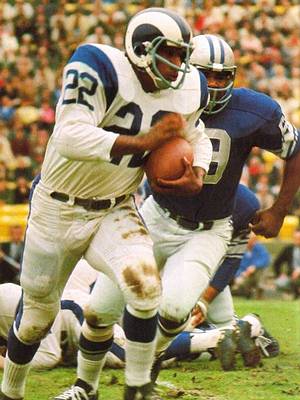

"Dick Bass"
HELMET REFLECTIONS FOR SEPTEMBER 2008
DICK BASS
By Dr. Ken
If there was one
thing that stood out about me as a
ten or twelve year old, especially
among a group of youngsters who were
for the most part, first or second
generation born-in-America
Americans, it was my penchant for
reading and carrying books with me.
In a previous HELMET
NEWS/REFLECTIONS article I noted
that the only bookstore in town had
displayed a copy of Robert Riger’s
“The Pros”, a 1960 photo essay about
professional football that was
perhaps the first of its kind. I was
enthralled and the kind gentleman
that owned the store allowed me to
purchase the book on the layaway
plan. I read constantly in a home
that did not otherwise have one book
inside of it. My parents’ education
was limited although my father could
work his way through the Racing Form
or other racetrack tout sheets and
knew his way around a structural
steel blueprint very well. Of course
I will be the first to admit that I
was the furthest thing from an
“intellectual” and my reading was
more or less confined to football
and baseball related books,
biographies, and magazine articles.
I was always scouring the magazines
of the town or school library and
requesting permission to remove
photos of different star players
from the older issues. The room that
my brother and I shared looked as if
it was decorated by football’s most
obsessed fan. I recall looking at
Time Magazine, not a usual choice
and certainly not to enhance my
knowledge of the day’s current
events. They frequently had football
related notes and brief pieces
during the season and in 1958, my
attention was captured by a
paragraph about someone named Dick
Bass who attended the College Of
Pacific which for all intents and
purposes, could have just as well
been the College Of Mars.
 |
The November 10, 1958 issue of Time Magazine noted that this guy Bass was “from little (enrollment: 1,670) College of the Pacific in Stockton, Calif.” and “Playing his first full season without crippling injuries, Dick Bass has performed the considerable feat of becoming football's leading ground-gainer on a team that gives him little real blocking, has gained 700 yds. in six games (Pacific lost three of them).” The brief paragraph listed his seventy-two yard kickoff return, his two touchdown runs, and his two passes for touchdowns that were nullified by penalty. Wow, Bass seemed great. When I purchased the following season’s Street And Smith College Football Yearbook, Bass was one of the first players I looked for and I was impressed that he was a preseason All American and hadn’t even attended one of the schools that “everyone” heard about. In retrospect, it seems unlikely that a high school star of Bass’ magnitude would play for a “small school” program like COP despite a rich tradition of success that the Tigers had.
To this day, many experts consider Dick Bass to be the greatest player in the history of Northern California high school football. Born in Mississippi, the family settled in California where Bass attended Vallejo High School. It will be difficult for many who don’t recall the limited offenses of the era but during the 1953 and ’54 seasons he rushed for 3690 yards, sixty-eight touchdowns, and had a yards-per-carry average of an unbelievable 13.2. Those 3690 yards came in only eighteen games, two nine game seasons that saw the Vallejo Apaches go 17-0-1 as Bass toted the ball but fifteen times per game. Until the ascension of the famed program at De LaSalle High School, that Vallejo team was considered perhaps the all-time greatest in the San Francisco Bay area. One can only imagine him playing in today’s extended twelve or fourteen game high school season with the modern day playoff system. As was usual for the time, especially in high school, Bass played excellent defense and as might be expected as the team’s best player, kicked off, kicked extra points and field goals, punted, and did all of the return work. With athletic ability in the family as evidenced by Bass’ younger brother Norm who was the first African-American since Jackie Robinson to play both professional football and baseball, Dick also starred in baseball, basketball, track, and was the city’s amateur welterweight boxing champion. That resume could have landed him at USC, UCLA, or any of the top rated schools in the nation but he chose to attend nearby College Of Pacific in Stockton, California with four of his high school teammates. At Pacific, he was no less effective than he had been at Vallejo but played on a small stage, far from the national spotlight. Still, that memorable Time Magazine article referred to him as “A One Man Show” on the field and he certainly was that. He led the entire country in rushing in his junior season of 1958 with 1361 yards and topped that off by also being ranked first in scoring and total offense, a rare “triple crown” feat. Not surprisingly, Pacific led the nation in rushing as a team because of Bass’ All American performance and the Tigers upset CAL in ‘58’s opening game, the same CAL team that went to the Rose Bowl at the end of that season. He racked up thirty-one touchdowns during his time at COP.
When Bass entered the pros as the Los Angeles Rams first round draft choice and the draft’s second overall choice, he was a hit, a superior rusher who gave me the impression that he was one of those quick and most importantly to me, small running backs that I could try to emulate. Until having the opportunity to see him in person when the Rams played against the Giants on October 22, 1961 and reading the program notation that Bass was in fact 5’10” and 200 pounds, I had viewed him in the 5’6” to 5’8” range. Of course, it didn’t matter by then because he was on my “favorites” list of running backs that I tried to copy. Following the fortunes of Bass and the Rams long distance from New York through newspaper accounts, Bass was a player I really liked, hard running as well as hard to catch because of his speed. Nicknamed “Scooter” because of his running style, former San Francisco Forty Niner tackle and College Football Hall Of Fame honoree Charlie Krueger who played against Bass twice a year, said that “Bass could beat you to death. He ran a lot like Hugh McElhenny. You couldn’t pin Mac in a phone booth and Bass was the same kind of elusive back.” In 1962, Bass became the first Ram to rush for more than 1000 yards and he completed his NFL career that stretched from 1960 through 1969 as a three-time Pro Bowl performer who totaled 5417 rushing yards and another 1841 coming out of his halfback position to receive passes. I just enjoyed watching him when I could. He ran hard and fast with great acceleration and never seemed to be stopped by one tackler.
 |
The Rams uniforms through
Bass’ years with the team were always a treat to see on television and of
course, on my visit to Yankee Stadium for that 1961 game, I noted that even
the white away uniforms did not diminish the beauty of the blue and gold
horned helmet design. With Bass and another favorite, Jon Arnett often
teamed together in the same backfield, the Los Angeles Rams, though far from
their glory years of the 1950’s, were a treat to watch and cheer for. As an
admirer of the Rams uniforms, watching Dick Bass’ performances that spanned
the entire decade and that of the Rams as they switched from the blue and
gold, to the blue and white helmets, made one appreciate the fact that it
was the Rams that had the initial pro football helmet design. Described as
modest by those who knew him, Bass worked as a radio analyst for the Rams
for many years and unfortunately died at the young age of sixty-eight. One
of the underrated players of his era, Dick Bass was to those who saw him
play, an inspiration.